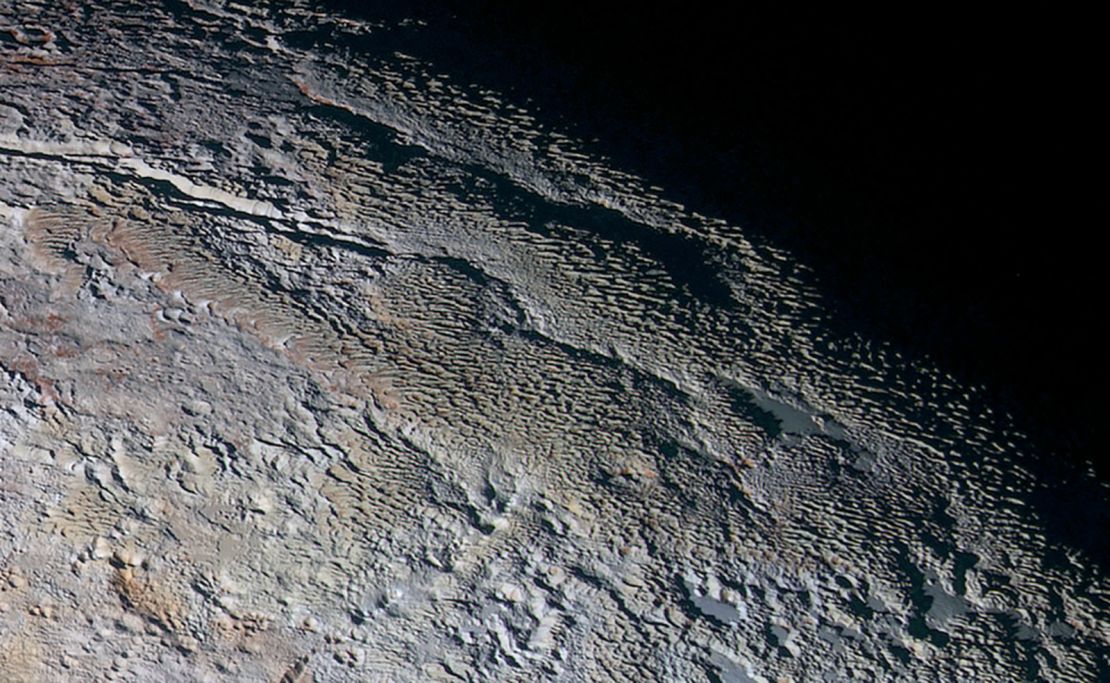Pluto’s snow-capped mountains look like they belong on Earth, but researchers have discovered that the snowy tops of these features are actually made of methane frost.
These mountains gather snow in a way entirely unlike anywhere else in the solar system.
The NASA New Horizon probe flew by Pluto in 2015, providing our closest and most detailed view of the dwarf planet to date. The probe revealed features that resembled those stunning snow-capped chains of mountains on Earth.
It’s yet another discovery made using New Horizons data that changes the way scientists understand Pluto.
The dwarf planet exists on the edge of our solar system in a place called the Kuiper Belt, where icy, old remnants of the solar system’s formation orbit the sun at such a great distance that they remain like frozen time capsules.
Pluto is 3.6 billion miles from the sun – 40 times the distance from Earth to the sun – and a single year takes 248 Earth years. This makes Pluto a cold place covered with ice, and its surface is between negative 378 to negative 396 degrees Fahrenheit.
Its thin atmosphere includes nitrogen, methane and carbon dioxide, and although the skies are blue on Pluto, the snow is red because of its chemical composition.
But in Pluto’s equatorial region, also called the Cthulhu region, bright white frosts collect on top of the red features in a striking way.
“Pluto is covered by exotic-composition ices and its landscape strongly resembles the polar caps on Earth (Greenland and Antarctica),” said Tanguy Bertrand, lead study author and a post-doctoral researcher at NASA Ames Research Center in California, in an email to CNN.
“New Horizons even discovered spectacular mountains on Pluto covered by bright deposits, strikingly resembling snow-capped mountain chains seen on Earth,” he said. “Such a landscape had never been observed elsewhere in the solar system. Could Pluto’s atmosphere behave like Earth’s? We discovered that a new and unique (in the solar system) atmospheric process forms these snowy mountains on Pluto.”
The study published Tuesday in the journal Nature Communications.

Pluto is covered in methane deposits, but those observed in the Cthulhu region look a lot like snow gathered on crater rims, walls and mountain tops. But scientists weren’t sure about the composition of these deposits – either rich in methane or a combination of methane and nitrogen – as well as how they formed.
Data gathered during the New Horizons mission allowed Bertrand and his colleagues to create high-resolution climate simulations to better understand the dwarf planet’s methane cycle. They discovered that the deposits of frost were rich in methane. But they don’t form like frost or snowpack on Earth.
On Earth, atmospheric temperatures decrease with altitude. The same occurs with surface temperatures as the altitude increases because the cold, dense atmosphere cools the surface, Bertrand said. So when moist wind approaches a mountain, it rises up the slope, cools and the water condenses to create snow-capped peaks, he said.
On Pluto, it’s the opposite.
While Pluto’s surface temperature remains incredibly cold, its atmosphere is actually warmed by the sun. Those temperatures rise as the altitude increases.
“At its contact the air is cooled and flows downslope,” Bertrand explained. “Pluto’s atmosphere has more gaseous methane at its warmer, higher altitudes, allowing for that gas to saturate and freeze directly on the mountain peaks tall enough to reach the enriched zone. At lower altitudes, the concentration of gaseous methane is lower, and it cannot condense.”
The researchers believe this same process could be responsible for other methane-rich deposits across Pluto.
It helps explain the presence of bladed terrain, or steep, narrow ridges on Pluto like the Tartarus Dorsa region, where methane deposits reign supreme.

These surface features are some of the steepest on Pluto, made largely of methane and a bit of water as well.
“This discovery teaches us that there are still plenty of physical and dynamical processes out there in space that we do not know about, and that climates can be very different than that of Earth (despite forming a similar landscape),” Bertrand said.
“It is important to study Pluto and other planetary bodies because they are natural laboratories to explore and investigate the diversity of possible climates (and geology, and other planetary sciences) which gives us more perspective on our own climate.”
Understanding Pluto also helps researchers understand what is common and unique for planetary climates, and it helps place Pluto’s climate on the scale of other climates known in our solar system, he said.







